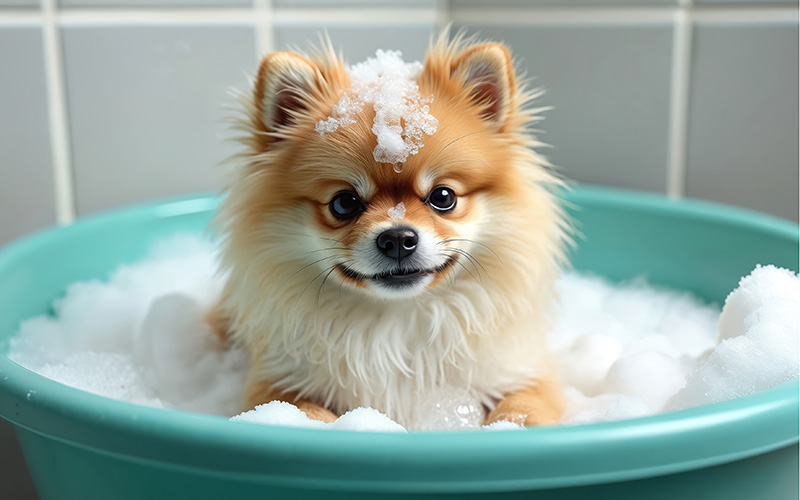When you’re making soap and cosmetic products, one of the easier brand extensions is to move into pet care products–for animals. Shampoos, conditioners, sprays, and other topical products intended to make animals look, feel, and smell better are becoming big business.
But a common—and critical—question arises: Are animal cosmetics regulated? And if so, what rules apply to the labeling and marketing of grooming products for animals like dogs, cats, horses, and even goats or cattle?
Let’s break down the current U.S. regulatory landscape—and touch on how it compares internationally.
What Are “Cosmetics” for Animals?
Well, to start with, the legal definition of a cosmetic is limited to products that are applied to the human body.
“The term ‘cosmetic’ means (1) articles intended to be rubbed, poured, sprinkled, or sprayed on, introduced into, or otherwise applied to the human body or any part thereof for cleansing, beautifying, promoting attractiveness, or altering the appearance… ”
Food Drug and Cosmetic Act 21 USC 321(i)
This definition does not extend to products intended for animals.
In fact, there is no official regulatory category for “animal cosmetics” under federal law. That means the regulatory framework depends on how the product is intended to be used and what claims are made.
Important note: Even if a cosmetic is marketed for animals, if you say it can also be used by humans on the label or in the marketing, then it IS a cosmetic (for humans) and all applicable cosmetic regulations would apply.
What Laws Do Apply in the U.S.?
1. Federal Trade Commission (FTC) – Consumer Product Labeling
Consumer products–that is, products that are purchased for use in the household, have basic label requirements. These are the same for ALL consumer products. The label must include:
- What the product is (product identity)
- Net contents
- Business name and address
There are specifications on where those items must be placed, how they should be presented, text size, etc.
An ingredient declaration is not required.
2. Federal Trade Commission (FTC) – Truth in Advertising
All marketing claims must be truthful, not misleading, and substantiated. This applies whether you’re marketing for people, pets, livestock, or exotic animals.
The FTC can take enforcement action if your advertising:
- Overstates benefits
- Implies therapeutic effect without evidence (and appropriate approval)
- Misleads consumers, even unintentionally
While including the ingredients on the label is not required (see above), if you do decide to list the ingredients on your “animal cosmetic,” ensure the ingredient list is accurate and doesn’t deceive the consumer in any way.
Also, keep in mind that not only does being untruthful in your advertising violate the law, but it also opens the door to lawsuits under state consumer protection laws.
3. FDA – Center for Veterinary Medicine (CVM)
The FDA’s CVM regulates animal drugs, animal food, and medical devices for animals—but not specifically cosmetics for animals. That said, just like a cosmetic can accidentally become an “unapproved new drug” (for humans), if you make any therapeutic or structure/function claims, your product may be considered a “new animal drug.”
For example:
- ❌ “Treats dry skin” or “Soothes hot spots” – drug claim
- ✅ “Leaves coat soft and shiny” – cosmetic/grooming
If your product is considered an animal drug, it is subject to:
- Premarket approval
- Manufacturing under current Good Manufacturing Practices (GMPs)
- Labeling compliance under the FD&C Act
And, just like getting a human drug approved, getting an animal drug approved is a long, expensive, and complicated process. Best not to go there!
Key Labeling & Marketing Best Practices
If you’re selling grooming products for animals and want to stay out of regulatory trouble, follow these best practices:
✅ DO:
- Follow fair packaging and labeling rules (net contents, directions for use, etc.)
- Use language like “cleans,” “freshens,” “softens coat,” or “makes fur smell nice”
- Keep marketing claims conservative and appearance-related
- If you use an ingredient declaration, include all ingredients on the label for transparency
❌ DON’T:
- Promote that it can also be used by people.
- Say or imply that the product “treats,” “cures,” “prevents,” or “heals” anything
- Claim parasite control or antibacterial effects
- Suggest the product changes the structure or function of the animal’s body
What About International Regulations?
While the EU, Canada, UK, and Australia have different laws and rules, all of them are about the same when it comes to animal cosmetics. Their definitions of cosmetics all include the human factor, so the laws governing cosmetics don’t apply to animal products, and none of them appear to have a separate category of regulations for animal cosmetics.
They do all have regulations that apply to animal DRUGS, and the types of claims that would cause a product to become a drug are about the same.
Finally, they all have general labeling specifications for all products, and requirements for truth in advertising and marketing.
Why It Matters
If you’re developing grooming products for animals—whether household pets or livestock—the rules may be less explicit than for human cosmetics, but they still matter.
Failing to understand the difference between a grooming product and an unapproved animal drug could expose your business to FDA enforcement, FTC scrutiny, or state-level legal action.
On the other hand, proper positioning and compliant labeling help you build consumer trust while staying on the safe side of the law.


Leave a Reply